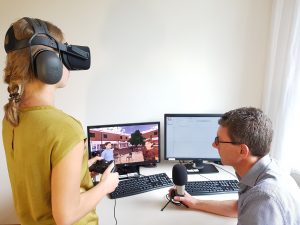What is it like to give VR therapy?
Monique Nederstigt tells:
Since March 2017 I have been working as a practitioner in the DiSCoVR pilot study with two other psychologists from the University Center for Psychiatry (UCP) at the outpatient clinic for psychoses. In the context of this research I therefore provide the DiSCoVR treatment to clients of the UCP.
Set goals
At the beginning of the training, we set goals with the participant. This may be, for example, that they want to become better at small talk (‘small talk’) or want to communicate more clearly and make their wishes better known. The challenge for me then is to examine with the participant which (social-cognitive) skills are needed for this purpose and which strategies they can best use. For example, looking at someone’s body language, thinking about how you would feel yourself, asking someone how he or she would feel in a certain situation or asking whether you have understood the other person correctly.

Practice with VR
These skills are practiced step by step in the assignments in the VR environment. Participants are given VR glasses and see and hear the avatars (virtual people) in the program. The participant looks at the avatars and has to determine which emotion is involved. They also see avatars in conversation with each other, the participant must then determine what these avatars think and feel and also argue this.
Roleplay
There is a lot of room for the participants’ own input. In the training, a lot is practiced with role plays. On the basis of the goals, situations are chosen and ‘re-enacted’ in the virtual environment by the practitioner and the participant. The practitioner talks to the participant through the avatar, with the practitioner’s voice being distorted by a microphone. In the beginning it is a strange experience for the participant to hear the avatar talking in, for example, a heavy male voice, while they know that this is the practitioner speaking to them. Fortunately, this soon happened. In this way situations can be practiced and in the debriefing it can be seen what can be improved.
Experiences
Participants experience that they are allowed to make mistakes, learn from them and do it all over again to improve themselves. Because they practice with avatars and not directly with the therapist, the exercises are perceived as more ‘real’, even though participants know they are in a virtual environment. I also like this more as a therapist. For example, if I have to criticize the participant in a role play, it is easier in VR. There is a bit more emotional distance because the criticism is expressed via the avatar. It is also clearer, the role play is through the avatar and the evaluation, after the role play, with the practitioner himself. In this way, the different roles of the practitioner do not overlap. VR therefore offers a safe environment in which practice situations can be tailor-made.
Enthusiastic participants and treating!
Participants are excited to work with this training. They tell me that in between sessions they have also started working on their goals and the newly learned interventions. The VR helps them to take this step more easily. I am also very enthusiastic about this treatment method and I expect, given the rapid developments, that the VR possibilities will be expanded and more advanced and who knows, also easier to apply in everyone’s consultation room.
